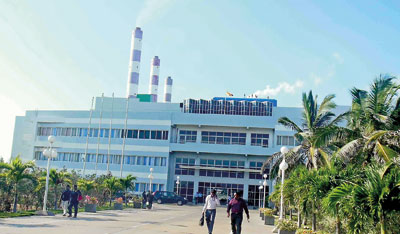News
Future dark if coal plant splutters
While authorities insist that the public need not worry about any potential power cuts during the Avurudu season and beyond, the country will have to rely heavily on the smooth functioning of the breakdown-prone Lakvijaya coal power plant in Norochcholai to ensure uninterrupted power.

The 900-megawatt (MW) Lakvijaya plant has been working at full capacity since early February as water levels in many hydropower reservoirs started falling steeply with the onset of dry weather
The 900-megawatt (MW) Lakvijaya plant has been working at full capacity since early February as water levels in many hydropower reservoirs started falling steeply with the onset of dry weather. Recent rains have done nothing to increase water levels or even prevent them from falling further. Total hydropower reservoir capacity was hovering just below 55 per cent by the middle of this week.
Against this backdrop, hydropower has contributed to only 15 to 20 per cent of total power generation during the past few days, CEB Spokesman Sulakshana Jayawardena noted. By contrast, coal power accounts for nearly 45 per cent while oil fired thermal power accounts for close to 40 per cent of power generation.
“All three 300MW units of Lakvijaya are working continuously. If one were to fail, there will likely be rotating power cuts island-wide until it’s repaired,” Ceylon Electricity Board Engineers’ Union (CEBEU) President Saumya Kumarawadu observed.
Luckily, CEB engineers carried out maintenance work on the plant last year when it was working at low capacity after heavy rains boosted hydropower generation. Because of this, the plant continues to function at full capacity – although there is always a risk of something going wrong.
In order to ensure uninterrupted electricity supply and cushion the impact of any electricity shortfall the government has also again turned to emergency power. This time, it is purchasing 100MW of emergency power supplies for six months, with the option to continue for a year.
CEB engineers are currently engaged in trade union action but reluctantly agreed to serve in the Technical Evaluation Committees appointed to evaluate bidders who bid for the emergency power tender, Mr. Kumarawadu added.
He stressed engineers were vehemently opposed to purchasing power from costly diesel-fired power plants but, given the danger of looming power cuts, went along with the proposal.
The engineers’ union president was frustrated at the prolonged delay in building the power plants needed to meet ever-growing demand for electricity.
While Sri Lanka’s energy demand grows by about 200MW each year, the government has not built a single new power plant since the last of Lakvijaya’s three units was commissioned in early 2015, he pointed out.
“We made a profit of Rs. 20 billion in 2015 due primarily to Lakvijaya but the CEB lost Rs. 40 billion last year. This is because we haven’t commissioned any new power plants and continue to purchase electricity from diesel power plants,” Mr. Kumarawadu said.
He blamed the continued delay in power plant construction on the ongoing dispute between the CEB and the Public Utilities Commission of Sri Lanka (PUCSL), the power sector regulator, over the country’s long-term power generation plan for 2018-2037.
He insisted the country needed an energy mix that envisaged power plants run by different sources, including hydro, coal, liquefied natural gas (LNG) and renewable energy sources. The PUCSL though, wants a “coal-free” plan and favors LNG. This is at the heart of the dispute, Mr. Kumarawadu said.
The dispute has now dragged on for months, with engineers refusing to serve on committees appointed to evaluate bidders for power purchases. Consequently, the construction of several power plants has been delayed indefinitely.
Notwithstanding all this tension, Power and Energy Ministry Secretary Dr. B.M.S. Batagoda is bullish, claiming that the government would move ahead with plans to set up several power plants in the coming weeks whatever happens.
He said negotiations on the construction of two 500MW LNG plants in Kerawalapitiya have been concluded with India and Japan, while a 400MW LNG plant is also due to begin construction in the coming weeks in Hambantota as part of a deal with the Chinese government. Tenders for other LNG, solar and wind power plants would be called soon.
He downplayed the decision to purchase 100MW of emergency power. “Just because we purchased this does not mean it will be automatically connected to the national grid,” Dr. Batagoda stressed.
He said the government would only pay fuel costs for the plants and would only purchase power from them if the necessity arose. The emergency power would be part of the extra stocks that the government would keep in reserve, the Secretary said.
Dr. Batagoda explained that the Ministry and CEB had to explore alternatives after the government scrapped plans to build a coal power plant in Sampur. “It took time to explore and finalise alternative arrangements and these issues came as a result of that. But they have now been sorted out and we will move ahead. There is no power crisis as some people claim,” he said.
The CEBEU, however, scoffed at suggestions that the government can move ahead with power plant construction without resolving the CEB-PUCSL dispute. “The main plants they are talking about are all unsolicited proposals that have come at government to government level,” Mr Kumarawadu said.
He claimed that under provisions in the Sri Lanka Electricity Act, the Ministry or the CEB could not legally move forward with power plants that are not included in the long-term power generation plan.
Moreover, he claimed 400MW and 500MW plants would not be suited for the country’s national grid. “Ours is still a small grid. The biggest capacity plant it can sustain at present is 300MW. Even the 900MW Lakvijaya plant has three separate 300MW units. Connecting a plant with far greater capacity runs the risk of it tripping, resulting in the collapse of the entire grid,” he warned.

